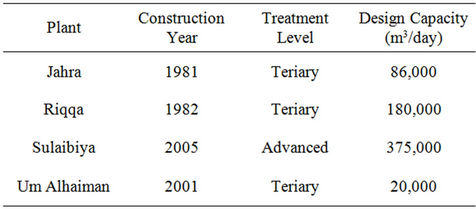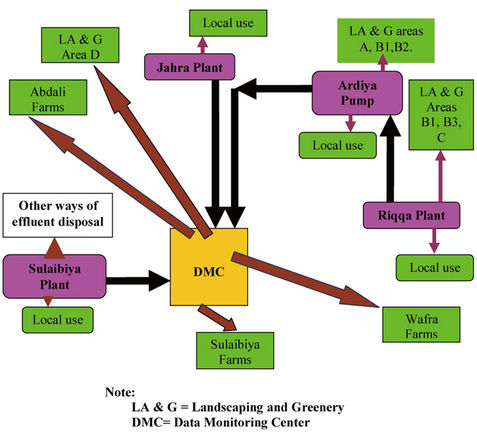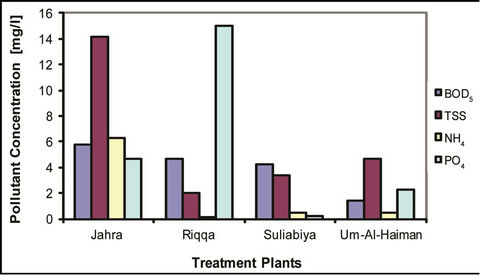Journal of Environmental Protection
Vol. 3 No. 8A (2012) , Article ID: 21773 , 5 pages DOI:10.4236/jep.2012.328108
Assessment of Wastewater Reuse in Kuwait and Its Impact on Amounts of Pollutants Discharged into the Sea
![]()
1Environmental Technology Management and Department, College for Women, Kuwait University, Kuwait City, Kuwiat; 2Water Technologies Department, Water Resources Division, Kuwait Institute for Scientific Research, Kuwait City, Kuwait.
Email: bader_anzi@yahoo.com
Received May 24th, 2012; revised June 27th, 2012; accepted July 28th, 2012
Keywords: Wastewater; Treatment; Reclamation; Reuse; Water pollution
ABSTRACT
Kuwait has recently implemented a vigorous campaign that aims to reclaim and reuse all treated wastewater in an attempt to alleviate water scarcity problem and to preserve seawater quality. This paper assesses the present status of wastewater treatment, reclamation and reuse in Kuwait, and discusses the impact of wastewater reuse on the amounts of pollutants discharged into the sea. Through analysis of the historical records of the wastewater treatment plants, it has been found that reuse of reclaimed wastewater in Kuwait has greatly reduced the amounts of pollutants discharged into the sea. Results showed that more than 50% reduction in volumes of wastewater discharged into the sea had been achieved from year 2000 to year 2010. However, this study has predicted that the amounts of wastewater discharged into the sea will start increasing again by the year 2020 due to shortages of storage capacity for reclaimed wastewater and due to the limitation of wastewater reuse applications to basically agricultural and landscape irrigations. In contrary, the on-going works and future plans of the Ministry of Public Works (MPW) are expected to overcome this problem and lead to a zero discharge of wastewater into the sea.
1. Introduction
Kuwait has one of severe arid climate in the world along with low annual rainfall of about 110 mm/yr while its fresh water resource is extremely limited. Kuwait mainly depends on seawater converted to potable water through costly multi-stage flash (MSF) distillation process. While exploring new alternatives to replenish and augment water resources reducing the deficit between demand and supply, the reuse option of treated wastewater has great potential in the state of Kuwait. Consequently, Kuwait has recently established wastewater reclamation plans that aim to augment its water resources by adding a new source of treated effluents. The prime goal of these plans is to utilize 100% of the reclaimed municipal wastewater mainly for nonhuman consumption such as in restricted agricultural irrigation (e.g. fodder crops irrigation), greenery landscaping (grass, plants, trees and bushes) and in the development of afforestation areas [1].
Treatment and reuse of such wastewater is also significant for environmental protection of land, air and aquatic ecosystems and further more for the conservation and replenishment of limited water resources through reusing of treated wastewater in irrigation purposes, which has proved to be one of the best ways to recycle nutrients and water and thus protect the environment and the public health [2]. It contributes directly to the environmental sustainability by increasing crop production and decreasing amounts of pollutants discharged into the environment.
The main aims of this paper are 1) to present and assess the status of wastewater treatment, reclamation and reuse in Kuwait, and 2) to discuss the impact of wastewater reuse on the amounts of pollutants discharged into the sea.
2. Municipal Wastewater Treatment and Reuse in Kuwait
2.1. Main Wastewater Treatment Plants in Kuwait
In modern urban living, wastewater generated from different sources are collected and treated in centralized wastewater treatment plants (WWTPs). Table 1 provides information about the construction year, treatment level and design capacity of the four main municipal wastewater treatment plants in Kuwait (Jahra, Riqqa, UmAl-Haiman and Sulaiybia). Presently, Kuwait generates about 600,000 m3/d of raw wastewater, 60% of which

Table 1. Basic information about Kuwait main municipal wastewater treatment plants [5].
(375 m3/d) is treated to an advance level using ultra filtration (UF) and reverse osmosis (RO) membrane filtration at Sulaibiya plant, which is the world’s largest membrane-based water reclamation facility. The rest of the generated wastewater (40%) is treated up to the tertiary level (rapid sand filtration and chlorination) by the three remaining wastewater plants employing conventional activated sludge processes. More details about the treatment systems used in the main wastewater treatment plants in Kuwait are given in Table 2.
As shown in Table 3, the raw wastewater treated at Kuwait municipal plants is basically a domestic wastewater that can be classified as a medium strength wastewater [3]. However, the high concentration of phosphorus contents of the raw wastewater is probably due to illegal discharges of industrial wastewaters into public sewers. Unfortunately, this action has been going on for quite long time as stated elsewhere [4].
2.2. Present Status of Wastewater Reuse in Kuwait
At present, the reuse of wastewater in Kuwait is limited mainly to agricultural and landscaping irrigations. Other reuse applications, such as urban (e.g., toilet flushing, vehicle washing and fire protection), industrial (e.g. cooling water, boiler feed and process water) and environmental (e.g., gulf courses, hunting and equestrian clubs) are not widely practiced in Kuwait. Furthermore, artificial groundwater recharge is still limited to experimental studies. Nonetheless, interests have been shown for urban uses of treated wastewater effluent (TWE). For example, Al-Ghusain [6] had studied the suitability of TWE produced in Kuwait for reuse in concrete mixing. He has concluded that Kuwait’s tertiary TWE is quite suitable for reuse in concrete mixing. Also there are interests in the reuse of greywater in Kuwait [7].
In fact, reuse of TWE in Kuwait has not just started recently. It is actually dated back to 1956, when the reuse of TWE was officially implemented at experimental farms [8]. Since then, the rate of TWE reuse in Kuwait is steadily increasing. Nowadays, reuse of TWE for irrigating only fodder crops and landscaping consumes more than 50% of the TWE produced daily [9]. Demands for TWE, however, are also steadily increasing due to reuse of TWE in different applications. For example, the Ministry of Electricity and Water (MEW) is requesting TWE for injection into the brackish aquifers. Further, Kuwait Oil Company (KOC) is asking RO brine water for oil explorations. Similarly, many factories (e.g. concrete mixing factories) are requesting TWE for reuse in various industrial operations [10].
2.3. Kuwait Wastewater Reuse Systems
Produced TWE in Kuwait is transported from the WWTPs to reuse places through underground distribution networks or tanker truck deliveries. Actually, there are two distribution networks for TWE in Kuwait: Ministry of Public Works (MPW) distribution network and Public Authority for Agricultural Affairs and Fish Resources (PAAF) distribution network. Both MPW and PAAF distribution networks consist of pump stations, gravity mains, and pressure mains. MPW distribution network links Jahra, Riqqa and Sulaibiya WWTPs to the storage reservoirs at the Data Monitoring Centre (DMC) in Sulaibiya area. From DMC, TWE is distributed further to the main farming areas of Sulaibiya, Abdali and Wafra areas. PAAF distribution network conveys TWE from Riqqa plant to greenery areas, projects A, B1, B2 and B3 (Figure 1). Other areas such as Fintas remote area receive TWE form Jahra, Um-Al-Haiman and Riqqa wastewater treatment plants.
At the DMC facility, TWE is stored and disinfected

Table 2. Treatment systems used in Kuwait main municipal wastewater treatment plants [5].

Table 3. Average influent concentrations (mg/l) at Kuwait’s main municipal plants in 2005 [5].

Figure 1. System of wastewater collection and reuse system in Kuwait [9].
(chlorinated) before being distributed to points of utilizations. The DMC premise is about 30 km away from the center of Kuwait City. It comprises six effluent storage reservoirs (ESRs), pump houses, chlorination units, a laboratory for water analysis and a computerized data management facility to generate data base for daily quantity and quality records of reservoir inflow and outflow. The total storage capacity of the six ESRs is 38,000 m3 [11]. However, MPW is now increasing the total storage capacity to 68,000 m3/d through building new reservoirs [10].
ESRs are usually used not only for storing the TWE, but also for regulating the TWE flow rate and improving its quality. Properly designed and operated ESRs have proved to achieve these desired objectives [12]. Through regulation of TWE flow rates according to reuse demands, ESRs help in the cultivation of large area of land to produce high crop yields [13]. Furthermore, ESRs also reduce water evaporation losses and subsequent increase in soil salinity (WHO, 2006). DMC depends mainly on chlorination as disinfectant to improve the bacteriological quality of the stored water.
3. Materials and Methods
Pollution loads were calculated only for TWE reused in agriculture and landscape irrigations. They were calculated as kg/d of total solid loads (TSS), five biological oxygen demand loads (BOD5), total nitrogen loads (TN) and total phosphorus loads (TP), through multiplying TWE average yearly volumetric flow rates by pollutants concentrations.
Pollutant loads were calculated using the records of the main municipal wastewater treatment plants (Jahra, Riqqa, Sulaibiya and Um-Haiman plants) for the years 2000, 2005, 2010 and 2020 (Parsons, 2001; MPW, 2006). Pollution loads for the year 2000 were considered to be the baseline to which the pollution loads in year 2005 and in future (year 2020) can be compared and assessed.
In fact, potential pollution loads expected for the year 2020 were estimated using volumes of TWE as predicted by Shahalam et al. [9] and pollutants concentration of 2005 assumed to be the same for year 2020.
Exact amounts of TWE discharged into the sea from wastewater treatment plants were actually not available for all year. For Kuwait, however, TWE not utilized as an irrigatant is usually discharged into the sea. Reuse applications of TWE other than agriculture are very limited and negligible [9]. Thus, pollution loads of TWE utilized as irrigation water reflects directly the impacts of wastewater reuse in Kuwait on pollutants discharges into the sea
4. Results and Discussion
4.1. TWE Production and Reuse
Figure 2 was generated to show the average amounts of TWE reused in Kuwait in irrigation purposes and that discharged into the sea (unused). Results show that the total amounts of TWE utilized for irrigation purposes in both agriculture and landscaping is increasing steadily with time.
From figure 2, one can also see that the amounts of TWE reused in agriculture and landscaping have been

Figure 2. Volume of TWE reused in agriculture, landscaping or discharged into the Sea.
doubled in five years (from 2000 to 2005). This trend is expected to continue even further until year 2020 where the utilization of TWE is going to exceed the current capacity reaching about 8000 m3/day. With respect to TWE discharged into the sea, however, the same figure shows that the discharges remain almost the same from years 2000 to 2005 and increase in year 2020. However, taking into consideration the total TWE daily produced, which is increasing over the years, the rate of TWE discharged into the sea had actually been reduced, by about half, from about 65% in year 2000 to about 30% in year 2010 (Figure 2).
4.2. Amount of TWE Discharged into the Sea
Figure 3 was generated to show this effect. As depicted in Figure 3, percentage of TWE discharged into the sea is expected to increase by about 10% (30% to 40%) from year 2010 to year 2020. This is due to the high amounts of TWE that are expected to be produced by year 2020 with the storage capacity remaining the same. As reported by Shahalam et al. [9], about 0.5 million of cubic meter of TWE in excess of present storage capacity is expected to be produced in 2020. Another reason is also the limitation of TWE reuse to basically agricultural and landscape irrigations. However, amounts of TWE discharged to sea will be zero with the completion of the on-going works and plans of the MPW. The MPW is actually doubling the available TWE storage capacity and diversifying the TWE reuse applications to include industrial applications, such as reuse of TWE in concrete mixing processes and RO-brine for oil exploration [10].
4.3. TWE Quality and Characteristics
With respect to reuse as an irrigant, the qualities of TWE produced during both 2000 (Figure 3) and 2005 (Figure 4) were within the acceptable standards proposed for Kuwait (Table 4). However, it should be noticed that effluents of Sulaibiya plant (Figure 4) were almost deprived of nutrients (N, P) essential for plants growth. Sulaibiya plant treats wastewater to advanced levels using UF and RO systems. The RO system is known to remove almost completely all the pollutants in wastewaters.

Figure 3. Percent of TWE discharged to the sea.

Figure 4. Average tertiary effluents qualities in 2000.

Table 4. Proposed standards (mg/l) for treated wastewater discharge into sea and for reuse as irrigation water in Kuwait [8].
This makes Sulaibiya effluents unsuitable for reuse as an irrigant. However, MPW is presently coordinating with KOC the reuse of RO brine in oil explorations [10].
Depending on the quality, continuous discharge of any type of wastewater into the sea can lead to many environmental and public health problems. These problems will be due to mainly excessive depletion of oxygen (high biological oxygen demand, BOD), autrophication (large amounts of N and P), presence of pathogenic microorganisms and presence of toxic chemicals (e.g. heavy metals and toxic organic compounds). Thus, Figures 4 and 5 show that continuous discharges from Jahra, Riqqa and Ardiya plants into the sea pose a potential threat to marine environment. The foregoing figures show that ammonia concentration of Jahra effluents was always exceeding the permissible limit of 3 mg/l. Similarly, PO4 concentration in both Ardiya and Riqqa effluents were significantly greater than the proposed standard of 8.8 mg/l (2 mg/l as phosphorus). Usually, P is considered as an indicator of illegal discharges of industrial wastewater into public sewers, which seems to be a common practice in Kuwait [4].
4.4. Reuse Effect on Amounts of Pollutants
In short, reuse of TWE for irrigation purposes in Kuwait has resulted in utilizing successfully large amounts of pollutants that would have been definitely ended into the sea. Figure 6 presents the amounts of pollutants that have been reused or will be reused in agriculture and landscaping during the years 2000, 2005 and 2020. It shows that the amounts of pollutants that have been or will be beneficially utilized are steadily increasing in Kuwait. As can be seen from this figure, the utilization

Figure 5. Average tertiary and advanced effluents qualities in 2005.

Figure 6. Amounts of pollutants utilized in agriculture and landscaping.
rates, namely of nutrients (TN and TP), are growing very rapidly. In fact, the rates have been doubled in compareson to that of year 2000.
5. Conclusions
• Reuse of reclaimed wastewater in Kuwait has greatly reduced the amounts of pollutants discharged into the sea.
• Volumes of wastewater discharged into the sea has been drastically reduced from about 65% in year 2000 to about 30% in year 2010.
• Volumes of wastewater discharged into the sea are predicted, however, to start to increase again by 2020. The main reasons for that are inadequate storage capacity for reclaimed wastewater and the limitation of the TWE reuse applications to basically agricultural and landscape irrigations. Completion of Ministry of Public Works (MPW) on-going activities, however, will stop completely the discharge of TWE into the sea.
6. Acknowledgements
Data used in this study were collected during the execution of a project entitled “Present and Future Wastewater Quantities and Reuse Demand in Kuwait (WT007C)” at KISR. This project was partially financed by the Kuwait Foundation for the Advancement of Sciences.
REFERENCES
- M. A. Razzaque, “Master Plan for Development of Kuwait’s Agricultural Sector (1995-2005),” Kuwait Institute for Scientific Research, Appendix IV, Vol. 5, AG-67, Report No. KISR 4615, Kuwait, 1995.
- WHO, “Guidelines for the Safe Use of Wastewater, Excreta and Grey Water,” Vol. 2, Wastewater Use in Agriculture, World Health Organization, France, 2006.
- MetCalf and Eddy, “Wastewater Engineering Treatment, Disposal, Reuse,” 3rd Edition, McGraw-Hill Publishing Company, Ltd., New York, 2003.
- F. Ghobrial, M. Lionel, B. Patel and A. Awad, “Assessment of Raw Sewage and Treated Effluents Characteristics in Kuwait”, Final Report, KISR 2468, Kuwait Institute for Scientific Research, Kuwait, 1987.
- MPW, “Treatment Plant Data,” (Personal Communication, MPW Staff), 2006.
- I. Al-Ghusain, “Use of Treated Wastewater for Concrete Mixing in Kuwait,” Kuwait Journal of Science and Engineering, Vol. 30, No. 1, 2003, pp. 213-228.
- A. Abusam, “Reuse of Greywater in Kuwait,” International Journal of Environmental Studies, Vol. 65, No. 1, 2008, pp. 103-108. doi:10.1080/00207230701868204
- Parsons, “Kuwait Sanitary Master Plan,” Parsons Engineering Science, Inc. and Gulf Consult, Kuwait, 2002.
- MPW, “Wastewater Reuse Plans,” (Personal Communication, MPW Staff), 2011.
- A. M. Shahalam, S. Al-Shammari, A. Abusam and H. Al-Naser, “Present and Future Wastewater Quantities and Reuse Demand in Kuwait,” Kuwait Institute for Scientific Research, KISR 8954R, Kuwait, 2008.
- H. Al-Rashidi, A. M. Shahalam and S. Alam, “Centralized Management of Treated Wastewater Reuse in Kuwait: Collection, Storage and Distribution,” Proceedings of the 7th Gulf Water Conference, Water in the GCC— Towards an Integrated Management, Kuwait, 19-23 November 2005, pp. 633-643.
- G. Mancini, C. Barone, P. Roccaro and F. G. A. Vagliasindi, “The Beneficial Effects of Storage on the Quality of Wastewater for Irrigation: A Case Study in Sicily,” Water Science and Technology, Vol. 55, 2007, pp. 417-424. doi:10.2166/wst.2007.042
- S. Barbagallo, G. L. Cirelli, S. Consoli and F. Somma, “Wastewater Quality Improvement through Storage: A Case Study in Sicily,” Water Science and Technology, Vol. 47, 2003, pp. 169-176.

